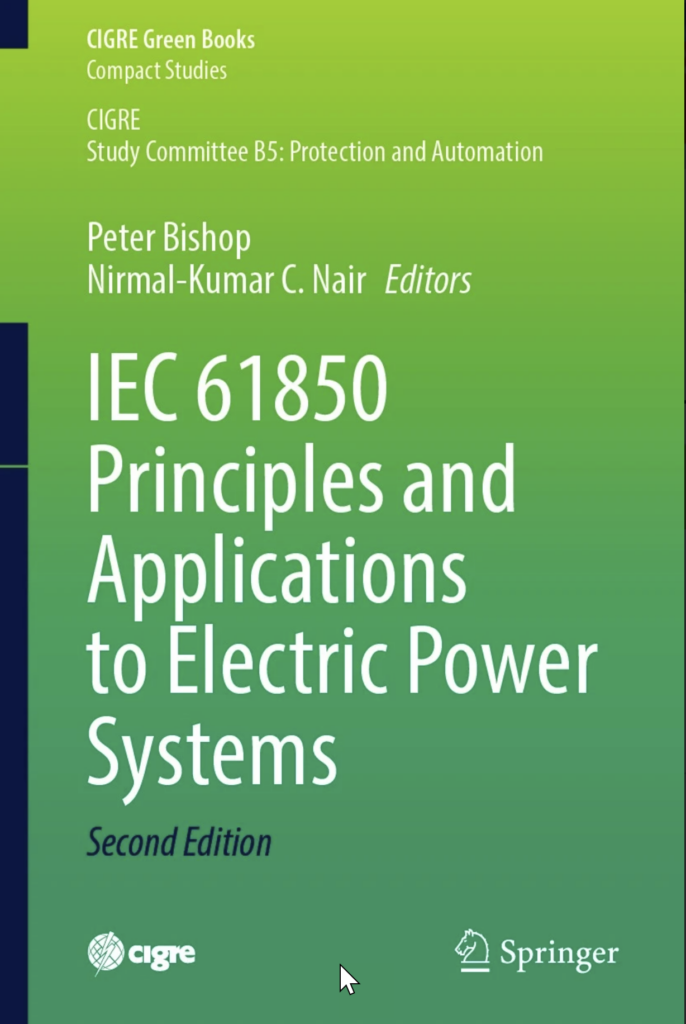review by Rannveig Loken, Norway

2nd Edition
IEC 61850 is an international standard for communication systems in substations and other power system facilities. CIGRE Study Committee B5- Protection and Automation has worked with the IEC 61850 Standard for more than 20 years.
This CIGRE Green Book aims to provide a compact overview on IEC 61850 principle and application to electric power systems. It is compiled using technical brochures and technical paper material that is based on existing practice of IEC 61850 systems that gives stakeholders from different disciplines an understanding of system in use, their features, how they applied and approach for implementation.
The book has more than 400 pages and is divided into 17 chapters. The different chapters are written by SC B5 members from different parts of the world with experience related to IEC 61850 system.
The first chapter introduces the broader reasons and advantages for applying IEC 61850- based systems to solve challenges in the power system.
The next chapter discuss the structure, data model, initial concepts, summary of history and compliance issues related to the IEC 61850 standard.
The third chapter introduces the IEC 61850 User specifications. It also covers specification process, system configuration language (SCL) and introduces different user groups that are providing feedback or helping with the maintenance of the IEC 61850 standard.
The next chapter discuss communication architecture on station bus and process bus like HRS and PRP, as well as services related to GOOSE, MMS and SV. Chapter 5 introduces time synchronization requirements for IEC 61850 systems. It includes accuracy requirements, precision time protocol (PRP), redundancy and some practical implementations.
In the next chapter a mythology to integrate cyber-physical security systems with IEC 61850 protection, automation and control system is described. It concludes with the top six cyber-physical response action to protect IEC 61850 systems.
Planning and design for IEC 61850 implementation is discussed in chapter 7. The various steps of planning and design, the requirements to be defined, the impact caused by the change and the strategies to be followed is presented.
The next chapter describes the recommendations and best practices of implementing IEC 61850 protection, automation and control functions and schemes. It covers architecture, general principle, and some actual cases. Chapter 9 introduces testing-related features of the IEC 61850 standard. It also includes requirements for testing tools and the different methods that can be used for different types of tests. The next chapter address interoperability aspects from utility perspective in IEC 61850 multi-vendor substations, including challenges, recommendations, suggestions to improve the specification, engineering, implementation, and testing of multi-vendor IEC 61850 systems.
Chapter 11 discuss how reliable and accurate operation of the complete digital acquisition chain improves the performance of PAC devices within modern power systems. It includes quality of Sampled Values and requirements in IEC 61869-9 standard.
The next chapter focus on Process bus Applications in IEC 61850. There are examples of papers using IEC 61850 Process bus Application with PRP architecture and HSR architecture.
Chapter 13 introduces Wide Area Implementations of IEC 61850 Substation Systems. It gives a review of the concept of the synchrophasor, the secure transmission of such via the IEC 61850 Routable Sample Values, an overview of and an array of Smart Grid applications based on the availability of secure event-based communications (Routable GOOSE). The next chapter discuss IEC 61850 for SCADA Applications. SCADA system’s function for remote operation and maintenance systems are also presented.
Chapter 15 Maintenance and Asset Management for IEC 61850 Systems presents aspects related to useful life, performance management, risk management, maintenance processes and asset information collection. The next chapter gives examples of IEC 61850 Applications Beyond Substations. It includes applications in electric traction systems, HVDC systems, storage and renewable energy generation, to demonstrate how these new ideas and concepts are emerging.
Chapter 17 concludes the Green book on IEC 61850, and identifies the future challenges and opportunities for enabling widespread adoption of IEC 61850 based systems and technologies globally. The book is a valuable resource and is recommended to anyone who wants to learn more about IEC 61850.
The editors are Peter Bishop and Nirmal- Kumar C. Nair.
Peter Bishop is a Principal Protection and Automation Engineer with Transpower NZ Ltd. He holds an Electrical and Electronic Engineering Degree from the University of Canterbury (NZ) and is a Chartered Professional Engineer. has over 25 years’ experience in power system protection engineering support and management for a transmission utility and protection manufacturer.
Nirmal-Kumar C. Nair has B.E. in electrical engineering from Maharaja Sayajirao University, Vadodara, India, M.E. (Gold Medal) in high voltage engineering from Indian Institute of Science, Bengaluru, India, and Ph.D. in electrical engineering from Texas A&M University, College Station, USA. He has held several positions in India, USA and New Zealand (NZ). Currently, he is a tenured faculty at the Department of Electrical, Computer Engineering and Software Engineering at University of Auckland, New Zealand.
IEC 61850 Principles and Applications to Electric Power Systems
Editors: Peter Bishop and Nirmal-Kumar C. Nair
Publisher: Springer, 2023
ISBN-13: 978-3-031-24567-1 (eBook)








